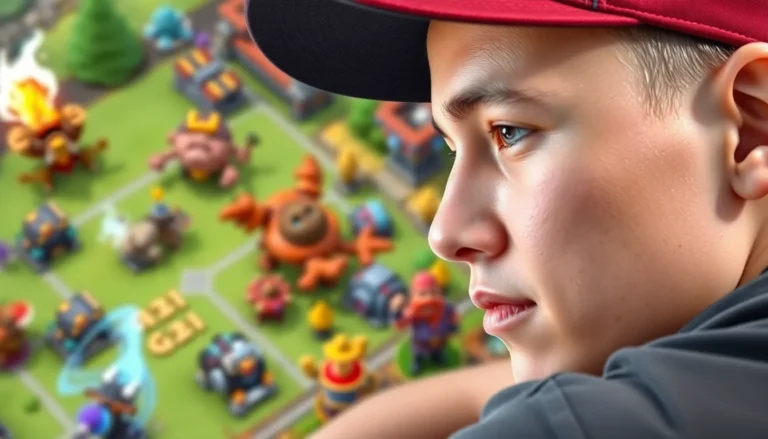In the chaotic world of Super Smash Bros, the stage isn’t the only battleground. Offstage play is where the real magic happens, and it’s often the most thrilling part of a match. Whether it’s a daring edge guard or a perfectly timed recovery, offstage moments can turn the tide of battle faster than you can say “K.O.”
Table of Contents
ToggleUnderstanding Smash Bros Offstage Play
Offstage play represents an essential and thrilling component of Super Smash Bros. Players leverage offstage moments to gain tactical advantages, shifting the match outcome significantly.
Definition and Importance
Offstage play refers to maneuvers executed beyond the stage, involving characters in an airborne state. This playstyle emphasizes the significance of edge guarding, where a player disrupts their opponent’s recovery attempts. Mastery of this tactic can lead to early KOs and a psychological edge. Engaging effectively in offstage scenarios heightens the complexity of matches, making it crucial for players to develop strategies and positions that capitalize on opponents’ vulnerabilities.
Key Mechanics Involved
Several mechanics come into play during offstage interactions. Recovery techniques assert how a character returns to the stage, with options like Up-B, Side-B, or jump capabilities. Edge guarding involves strategic positioning and timing to intercept opponents attempting to return. Players often utilize aerial attacks and projectiles to hinder recovery routes. Understanding hitboxes, distances, and stage layouts enhances these strategies, allowing players to dominate offstage encounters. Prioritizing these key mechanics improves overall gameplay effectiveness in Super Smash Bros.
Strategies for Effective Offstage Play

Offstage play in Super Smash Bros involves a mix of aggressive techniques and defensive maneuvers that players can master for enhanced performance.
Aggressive Techniques
Players can utilize various aggressive techniques to control the offstage area. Fast aerials create pressure on opponents attempting to recover. Spiking can lead to early KOs, especially against characters with limited recovery options. Confirming opponent’s movements allows players to predict recovery attempts more accurately. Edge hogging prevents opponents from grabbing the ledge, increasing chances of securing a knockout. Using projectiles while opponents are offstage can limit their recovery options, forcing them into tough situations. Combinations of these aggressive strategies establish dominance during crucial offstage moments.
Defensive Maneuvers
Employing defensive maneuvers proves vital for surviving offstage encounters. Recognizing opponents’ attack patterns allows players to strategize their positioning effectively. Utilizing invincibility frames during recovery can minimize vulnerability when returning to the stage. Air dodging provides an escape mechanism against approaching attacks, giving players time to reposition. Timing jumps correctly helps avoid spikes while maximizing height for recovery. Maintaining knowledge of character-specific recoveries enables players to anticipate threats and react accordingly. Combining these defensive tactics fosters resilience during offstage challenges.
Common Mistakes to Avoid
Offstage play presents unique challenges. Recognizing common mistakes is vital for improvement.
Overcommitting
Overcommitting occurs when players execute aggressive moves without considering their positioning. They might venture too far from the stage, making them vulnerable to counterattacks. A misguided aerial attack can lead to an easy punish from an opponent. Players should avoid chasing foes excessively, as this can result in losing stage control. Maintaining a balance between aggression and caution will protect players from unnecessary risks. High-level play emphasizes the importance of smart engagements while leaving room for strategic retreats.
Poor Recovery Choices
Making poor recovery choices can sabotage a player’s offstage performance. Choosing the wrong recovery move or timing can lead to immediate knockouts. Players often underestimate the distance needed for proper recovery. Not evaluating an opponent’s position can result in being caught off-guard. Instead, they should assess the situation before committing to a recovery tactic. Utilizing safe options, like jumping offstage for an aerial attack, often secures a better chance for survival. Understanding character-specific recovery mechanics significantly enhances resilience in these critical moments.
Character-Specific Offstage Play
Offstage play varies significantly across different characters, influencing their effectiveness in edge guarding and recovery.
Best Characters for Offstage Play
Several characters excel in offstage situations. Characters like Wolf and Yoshi provide strong aerial attacks, making edge guarding more effective. Fast characters such as Fox and Sheik can pressure opponents during recovery attempts. Projectiles from characters like Link and Samus can limit recovery options, forcing opponents into unfavorable positions. Characters with powerful spikes, such as Ganondorf and Mario, can secure early KOs with precise timing. Understanding each character’s strengths enhances a player’s decision-making in offstage scenarios.
Character Weaknesses in Offstage Situations
Certain characters struggle offstage. Heavy characters like Bowser and Donkey Kong often face difficulties when recovering due to their slower aerial speed. Characters with limited mobility, such as Little Mac, are vulnerable during offstage encounters. Frail characters like Peach and Zelda tend to have poor recovery options, making them susceptible to edge guarding. Lack of invincibility frames on some recovery moves can lead to early KOs. Awareness of these weaknesses helps players exploit opponents’ vulnerabilities during offstage play.
Mastering offstage play in Super Smash Bros is essential for any competitive player. The ability to execute effective edge guarding and recovery techniques can turn the tide of a match. Players who understand the nuances of offstage interactions can gain a significant advantage over their opponents.
Balancing aggression with caution is key to thriving in these high-stakes moments. By recognizing character strengths and weaknesses, players can tailor their strategies to maximize their effectiveness. Whether using pressure tactics or defensive maneuvers, a well-rounded approach to offstage play can lead to victory.
Ultimately, honing these skills not only enhances gameplay but also elevates the overall experience of Super Smash Bros. Embracing the challenges of offstage encounters will undoubtedly lead to improved performance and greater enjoyment of the game.



